Allies of World War II

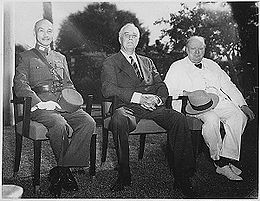
The Allies of World War II, were one of the two diplomatic and military blocs of nations which fought the greatest conflict of the 20th century, the Second World War (1939–1945), their opponents being known as the Axis powers. Former Axis states contributing to the allied victory are not considered Allied states. The Allies became involved in World War II either because they had already been invaded or were directly threatened with invasion by the Axis or because they were concerned that the Axis powers would come to control the world.[1] The anti-German coalition at the start of the war, on 1 September 1939, consisted of France, Poland, and the United Kingdom.[2] After 1941, the leaders of the British Empire, the Union of Soviet Socialist Republics, and the United States of America, known as "The Big Three",[3] held leadership of the allied powers. France, before its defeat in 1940 and after Operation Overlord in 1944, as well as China[4][5][6] at that time, were also major Allies.[7] Other Allies included Australia, Belgium, Brazil, Canada, Czechoslovakia, Ethiopia, Greece, India, Mexico, the Netherlands, New Zealand, Norway, the Philippine Commonwealth, Poland, the Union of South Africa, and Yugoslavia.[8]
During December, 1941, U.S. President Franklin Roosevelt devised the name "United Nations (UN)" for the Allies. He referred to The Big Three and China as a "trusteeship of the powerful", and then later "the Four Policemen".[9] The Declaration by United Nations, on 1 January 1942, was the basis of the modern UN.[10] At the Potsdam Conference of July–August 1945, Roosevelt's successor, Harry S. Truman, proposed that the foreign ministers of China, France, the Soviet Union, the United Kingdom and the United States "should draft the peace treaties and boundary settlements of Europe", which led to the creation of the Council of Foreign Ministers.[11]
Contents |
History
China
China was aided by the Soviet Union, which helped to reorganise the party, superficially at least, along Leninist lines: a unification of party, state, and army. However, following the nominal unification of China in 1928, Chiang Kai-shek purged leftists from his party and fought against the Chinese Communist Party, former warlords, and other militarist factions. A fragmented China provided easy opportunities for Japan to gain territories piece by piecewith a foking nation without engaging in total war. Following the 1931 Mukden Incident, the puppet state of Manchukuo was established. Throughout the early to mid 1930s, Chiang's anti-communist and anti-militarist campaigns continued while he fought small, incessant conflicts against Japan, usually followed by unfavorable settlements and concessions.
In the early 1930s, Germany and China became close partners in military and industrial matters. Nazi Germany provided the largest proportion of Chinese arms imports and technical expertise. Following the Marco Polo Bridge Incident of 7 July 1937, China and Japan became embroiled in a full-scale war which continued until 1945. The Soviet Union, wishing to keep China in the fight against Japan, supplied China with some military assistance until 1941, until it signed friendship with Japan.
Even though China had been fighting the longest among all the Allied powers, it only officially joined the Allies after the attack on Pearl Harbor, on 7 December 1941. Chiang Kai-shek felt Allied victory was assured with the entrance of the United States into the war, and he declared war on Germany and the other Axis nations. However, Allied aid remained low because the Burma Road was closed and the Allies suffered a series of military defeats against Japan early on in the campaign. The bulk of military aid did not arrive until the spring of 1945. More than 1.5 million Japanese troops were trapped in the China Theatrelol; troops that otherwise could have been deployed elsewhere if China had collapsed and made a separate peace.
French, British and Polish relations
The original Allies were those countries that linked themselves in a military defence pact in August 1939, following Adolf Hitler's explicit threats against Poland, triggering the war.
These countries were allied to each other by a net of common defence pacts and military alliance pacts signed before the war. The Franco-British Alliance dated back to the Entente cordiale of 1904 and the Triple Entente of 1907, active during the World War I. The Franco-Polish Alliance was signed in 1921 and then amended in 1927 and 1939. The Polish-British Common Defence Pact, signed on 25 August 1939, contained promises of mutual military assistance between the nations in the event either was attacked by Nazi Germany.
The invasion of Poland on 1 September 1939, started the war in Europe, and the United Kingdom and France declared war on Germany on 3 September. Poland fielded the third biggest army[13] among the European Allies, after the Soviet Union and United Kingdom, but before France. The country never officially surrendered to the Third Reich and continued the war effort under the Polish government in exile. However, the Soviet Union unilaterally considered the flight to Romania of President Ignacy Mościcki and Marshal Edward Rydz-Śmigły on 17 September as an evidence of debellatio causing the extinction of Polish State, and consequently declared itself allowed to invade (according to Soviet position: “to protect”) Eastern Poland starting from the same day.[14]
Home Army, the biggest underground force in Europe, and other resistance organizations in occupied Poland provided intelligence that enabled successful operations later in the war and led to uncovering the Nazi war crimes (i.e., death camps) to the Western Allies. Notable Polish units fought in every campaign in Europe and North Africa (outside the Balkans). Polish Armed Forces in the West were created in France and, after its fall, in the United Kingdom. The Soviet Union recognized the London-based government but broke diplomatic relations after the revelation of the Katyn massacre. In 1943, the Soviet Union organized the Polish People's Army under Zygmunt Berling, around which it constructed the post-war successor state People's Republic of Poland. The Polish People's Army took part in the Battle of Berlin, the closing battle of the European theater of war.
British Commonwealth
The United Kingdom and other independent members of the British Commonwealth, known as the Dominions, declared war on Germany separately, either on the same day, or soon afterwards; these countries were Canada, Australia, New Zealand and South Africa. However, Newfoundland had given up self-rule and was at the time under effective rule from the UK; it did not become part of Canada until 1949. Southern Rhodesia, while self-governing, did not have independence in foreign policy or military matters.
Following the Statute of Westminster in 1931, the Dominions of the British Commonwealth had independence in foreign policy. Australia and New Zealand accepted and reiterated the British declaration of war on Germany. The South African Prime Minister, Barry Hertzog, refused to declare war, leading to the collapse of his coalition government on 6 September; the new Prime Minister, Jan Smuts, declared war that same day. Canada declared war on Germany on 10 September; this was necessary as Canada had ratified the Statute.
The Indian Empire (including the areas and peoples covered by the later Republic of India, Bangladesh and Pakistan) and territories controlled by the Colonial Office, namely the Crown Colonies, were controlled politically by the UK and therefore also entered hostilities with Britain's declaration of war. The Indian Empire contributed about 2,500,000 personnel. It suffered 1,500,000 civilian casualties (more than the United Kingdom), mainly from the Bengal famine of 1943 caused by the fall of Burma to the Japanese,[15] and 87,000 military casualties (more than any Commonwealth country but fewer than the United Kingdom). The UK suffered 382,000 military casualties.
France
France experienced several major phases of action during World War II:
- The "Phoney War" of 1939–1940, also called drôle de guerre in France, dziwna wojna in Poland (both meaning "Strange War"), or the "Sitzkrieg" ("Sitting War") in Germany.
- The Battle of France in May–June 1940, which resulted in the defeat of the French Army, the fall of the French Third Republic and the creation of the rump state Vichy France which received diplomatic recognition by the major part of the international community, including the government of the United States.
- The period of French Resistance and Free French Forces, from 1940–1944, until the June 1944 D-Day invasions part of the Battle of Normandy and the August 1944 invasion of southern France in Operation Dragoon, which led to the Liberation of Paris on 25 August 1944 and the liberation of France by the allies. Free France was a government-in-exile recognized, between major Allies, only by Britain.
- The political creation of the Provisional Government of the French Republic, and the military actions following the redesignation of "French Army B" as the First French Army, including the final drive on Germany, which culminated in V-E Day, on 7 May 1945.
Oslo Group
The Oslo Group was an organisation of officially neutral countries. Four members later joined the Allies, as governments in exile: the Kingdom of Norway, the Kingdom of the Netherlands, the Kingdom of Belgium and the Grand Duchy of Luxembourg.
The Republic of Finland was attacked by the USSR on 30 November 1939.[16] Later the Kingdom of Denmark officially joined the Axis Anti-Comintern Pact after being occupied by German forces. Also Finland signed the Anti-Comintern Pact. The Kingdom of Sweden remained officially neutral. Following the Moscow armistice of September 1944, Finland effectively helped the Allies and expelled German forces. This led to a series of armed clashes called the Lapland War.
Denmark was invaded by Germany on 9 April 1940. The Danish government did not declare war and it surrendered the same day, on the understanding that it retain control of domestic affairs, but it was disbanded by Germany in 1943. No government-in-exile was formed. Danes fought with both Allied and Axis forces. Iceland, Faroe Islands and Greenland, which were respectively in union with Denmark and a Danish colony, were occupied by the Allies for most of the war. British forces took control in Iceland on 10 May 1940, and it was used to facilitate the movement of Lend Lease equipment. Forces from the United States, although they were officially neutral at the time, occupied Greenland on 9 April 1941. The U.S. also took over in Iceland on 7 July 1941. Iceland declared full independence from Denmark in 1944, but never declared war on any of the Axis powers. Finally, Denmark officially joined the Allies immediately after its liberation on 5 May 1945.
Portugal
Although Portugal remained officially neutral, and the Salazar dictatorship admired Fascist regimes, there was the Anglo-Portuguese Alliance — the world's oldest military alliance (1373) — reactivated by the United Kingdom during World War II, leading to the establishment of an Anglo-American base in Lajes, Terceira Island, Azores, which Salazar finally accepted (in December 1943). From 1940, both Churchill and Roosevelt were facing the possibility of a preventive occupation of Azores.[17] Portugal also protested the occupation of Portuguese Timor by Allied forces in 1942 but did not actively resist. The colony was subsequently occupied by Japan. Timorese and Portuguese civilians assisted Australian commandos in resisting the Japanese.
Soviet Union

On 20 August 1939, Soviet forces under General Georgy Zhukov eliminated the threat of conflict in the east with a decisive victory over Japan at the Battle of Khalkhin Gol. On the same day, Soviet party leader Joseph Stalin received a telegram from German Chancellor Adolf Hitler, suggesting that German Foreign Minister Joachim von Ribbentrop fly to Moscow for diplomatic talks. (After receiving a lukewarm response throughout the spring and summer, Stalin abandoned attempts for a better diplomatic relationship with France and the United Kingdom.)[18] On 23 August Ribbentrop and Soviet Foreign Minister Vyacheslav Molotov signed the Nazi-Soviet Pact pledging non-aggression, and including secret protocols dividing Eastern Europe into defined “spheres of influence” for the two regimes, and specifically concerning the carving up of the Polish state.[19]
On 15 September 1939, Stalin concluded a durable ceasefire with Japan, to take effect the following day (it would be upgraded to a formal armistice in April 1941).[20] The day after that, 17 September, he belatedly joined Germany in the joint invasion of Poland. Although some fighting continued until 5 October, the two invading armies held at least one joint victory parade on 25 September, and reinforced their partnership with a German–Soviet Treaty of Friendship, Cooperation and Demarcation on 28 September.
On 30 November, the Soviet Union attacked Finland, for which it was expelled from the League of Nations. The following year, the USSR annexed the Baltic states of Estonia, Latvia, and Lithuania, together with parts of Romania.
German-Soviet treaties were brought to an end by the German surprise attack on the USSR on 22 June 1941. The Soviet Union so entered in alliance with the United Kingdom. Following the USSR, these socialist, pro-Soviet or Soviet controlled forces fought against the Axis powers during the Second World War: the Albanian National Liberation Front, the Chinese Red Army (a.k.a 8th Route Army; ROC 18th Army or; New Fourth Army), the Greek National Liberation Front, the Hukbalahap, the Malayan Communist Party, the People's Republic of Mongolia, the Polish People's Army, the Tuvinian People's Republic (annexed by Soviet Union in 1944),[21] the Viet Minh and the Yugoslav Partisans.
Mexico
Mexico was pulled into WWII after German submarines attacked Mexican oil tankers, Potrero del Llano and the Faja de Oro, tankers that were transporting crude oil to the United States. These attacks prompted President Manuel Avila Camacho to declare war on the Axis powers.
Mexico responded by forming Escuadrón 201, a Mexican fighter squadron, part of the Fuerza Aérea Expedicionaria Mexicana (FAEM—"Mexican Expeditionary Air Force"). The squadron aided the Allied war effort during World War II. The squadron was commonly known, apparently coined by members of the (Toast) squadron during training, by the nickname Aguilas Aztecas, or "Aztec Eagles".[22]
The squadron was attached to the 58th Fighter Group of the United States Army Air Forces during the liberation of the main Philippine island of Luzon in the summer of 1945. The pilots flew P-47D-30-RA "Thunderbolt" single-seat fighter aircraft carrying out tactical air support missions.
Atlantic Charter
The Atlantic Charter was negotiated at the Atlantic Conference by British Prime Minister Winston Churchill and U.S. President Franklin D. Roosevelt, aboard warships in a secure anchorage at NS Argentia, Newfoundland (located on Placentia Bay) and was issued as a joint declaration on 14 August 1941.
The Atlantic Charter established a vision for a post-World War II world, despite the fact the United States had yet to enter the war.
In brief, the nine points were:
- no territorial gains sought by the United States or the United Kingdom;
- territorial adjustments must be in accord with wishes of the people;
- the right to self-determination of peoples;
- trade barriers lowered;
- global economic cooperation and advancement of social welfare;
- freedom from want and fear;
- freedom of the seas;
- disarmament of aggressor nations, postwar common disarmament;
- defeat of Germany and other Axis powers.
The Atlantic Charter proved to be one of the first steps towards the formation of the United Nations.
The United States of America joined the Allies following the attack on Pearl Harbor, on 7 December 1941. The Declaration by United Nations, on 1 January 1942, officially united 26 nations as Allies. The informal Big 3 alliance of the United Kingdom, the Soviet Union, and the United States emerged in the later half of the war, and their decisions determined Allied strategy around the world.
Pan American Union
The members of the Pan American Union, who were all neutral between 1939 and 1941, formed a mutual defense pact at a conference of foreign ministers at Havana, on 21 July 1940 – 30 July 1940. The "Declaration on Reciprocal Assistance and Cooperation for the Defense of the Nations of the Americas" was part of the Final Act of the Second Meeting of the Ministers of Foreign Affairs of the American Republics at Havana, Cuba, July 30, 1940.[23] There were twenty-one signatories:
.svg.png) Bolivia
Bolivia.svg.png) Brazil
Brazil Chile
Chile Colombia
Colombia Costa Rica
Costa Rica Cuba
Cuba Dominican Republic
Dominican Republic El Salvador
El Salvador Guatemala
Guatemala Haiti
Haiti Honduras
Honduras.svg.png) Mexico
Mexico Nicaragua
Nicaragua Panama
Panama United States
United States Venezuela
Venezuela
From this group, three countries contributed military forces to the Allied war effort:
- United States
- Brazil, from 1942, participated in anti-submarine warfare in the South and Central Atlantic and; in July 1944 sent an Expeditionary Force of 25,000 army and air force personnel to the Italian campaign;
- Mexico, in March 1945 sent an air force unit, Escuadrón 201 to join the U.S. Far East Air Force, during the Philippines campaign.
The other 18 countries from this group contributed given support in many ways on lesser degrees or limited to war declaration.
United Nations
Declaration by United Nations

The alliance was formalised in the Declaration by United Nations on 1 January 1942. There were 26 signatories:
 Australia
Australia.svg.png) Belgium
Belgium British India
British India Canada
Canada Republic of China
Republic of China.svg.png) Costa Rica
Costa Rica Cuba
Cuba Czechoslovakia
Czechoslovakia Dominican Republic
Dominican Republic El Salvador
El Salvador Greece
Greece Guatemala
Guatemala Haiti
Haiti Honduras
Honduras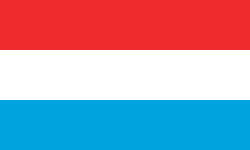 Luxembourg
Luxembourg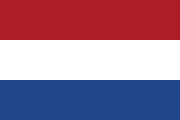 Netherlands
Netherlands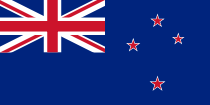 New Zealand
New Zealand Nicaragua
Nicaragua Norway
Norway Panama
Panama Poland
Poland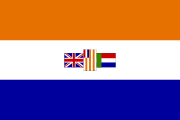 South Africa
South Africa United Kingdom
United Kingdom Soviet Union
Soviet Union United States of America
United States of America Yugoslavia
Yugoslavia
Alliance growing

The United Nations began growing immediately after their formation. In 1942, Mexico, Philippines and Ethiopia adhered to the declaration. The African nation had been restored in its independence by British forces after the Italian defeat on Amba Alagi in 1941, while Philippines, still dependent on Washington but granted international diplomatic recognition, was allowed to join on 10 June despite their occupation by Japan.
During 1943, the Declaration was signed by Iraq, Iran, Brazil, Bolivia and Colombia. A Tripartite Treaty of Alliance with Britain and USSR formalised Iran's assistance to the Allies.[24] In Rio de Janeiro, Brazilian dictator Getúlio Vargas was considered near to fascist ideas, but realistically joined the United Nations after their evident successes.
In 1944, Liberia and France signed. The French situation was very confused. Free France forces were recognized only by Britain, while United States considered Vichy France as the legal government of the country until Operation Overlord, also preparing US occupation francs. Winston Churchill urged Roosevelt restoring France in its status of a major Power after the liberation of Paris in August 1944: the Prime Minister feared that after the war, Britain could remain the sole great Power in Europe facing Communist threat, as it was in 1941 against Nazism.
During the early part of 1945, Peru, Chile, Paraguay, Venezuela, Uruguay, Turkey, Egypt, Saudi Arabia, Lebanon, Syria (these latter two French colonies had been declared independent nations by British occupation troops, despite big protests by Petain before, and De Gaulle after) and Ecuador became signatories. Ukraine and Belarus, although not being independent nations but only members of Soviet Union, were accepted between the United Nations, as a form of reassurance by US and UK to Stalin who had Yugoslavia as the sole official communist partner into the alliance.
Charter of the United Nations
The Charter of the United Nations was agreed to during the war at the United Nations Conference on International Organization, held between April and July 1945. The Charter was signed by 50 nations on 26 June (Poland had its place reserved and later became the 51st "original" signatory), and was formally ratified shortly after the war on 24 October 1945. The four leading Allied nations, namely China, the Soviet Union, the United Kingdom, and the United States met repeatedly during the war, such as at the 1944 conference at Dumbarton Oaks where the formation and permanent seats of the United Nations Security Council were decided. The Security Council met for the first time in the immediate aftermath of war on 17 January 1946.[25]
.svg.png)
These are the original 51 signatories (Security Council Permanent members are asterisked):
Summary of Allied declarations of war on Axis Powers
After the German invasion of Poland
 Poland: 1 September 1939
Poland: 1 September 1939 Australia: 3 September 1939
Australia: 3 September 1939 France: 3 September 1939 [26]
France: 3 September 1939 [26] New Zealand: 3 September 1939
New Zealand: 3 September 1939 United Kingdom: 3 September 1939
United Kingdom: 3 September 1939
 British India: 3 September 1939 [4][6][27][28]
British India: 3 September 1939 [4][6][27][28]
 South Africa: 6 September 1939
South Africa: 6 September 1939 Canada: 10 September 1939
Canada: 10 September 1939 Denmark: 9 April 1940 [29]
Denmark: 9 April 1940 [29] Norway: 9 April 1940
Norway: 9 April 1940
After the Phoney War
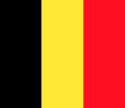 Belgium: 10 May 1940
Belgium: 10 May 1940 Luxembourg: 10 May 1940
Luxembourg: 10 May 1940 Netherlands: 10 May 1940
Netherlands: 10 May 1940 Greece: 28 October 1940
Greece: 28 October 1940 Yugoslavia: 6 April 1941 [30]
Yugoslavia: 6 April 1941 [30]
After the invasion of the USSR
 Soviet Union: 22 June 1941 (cooperated with Axis during Invasion of Poland)
Soviet Union: 22 June 1941 (cooperated with Axis during Invasion of Poland).svg.png) Ukraine: 22 June 1941 [31]
Ukraine: 22 June 1941 [31].svg.png) Byelorussian SSR: 22 June 1941
Byelorussian SSR: 22 June 1941
After the attack on Pearl Harbor
 Panama: 7 December 1941
Panama: 7 December 1941 Costa Rica: 8 December 1941
Costa Rica: 8 December 1941 Dominican Republic: 8 December 1941
Dominican Republic: 8 December 1941 El Salvador: 8 December 1941
El Salvador: 8 December 1941.svg.png) Haiti: 8 December 1941
Haiti: 8 December 1941 Honduras: 8 December 1941
Honduras: 8 December 1941 Nicaragua: 8 December 1941
Nicaragua: 8 December 1941 United States of America: 8 December 1941
United States of America: 8 December 1941 China: 9 December 1941 [32]
China: 9 December 1941 [32] Guatemala: 9 December 1941
Guatemala: 9 December 1941 Cuba: 9 December 1941
Cuba: 9 December 1941.svg.png) Philippine Commonwealth: 9 December 1941 [4][6][28][33]
Philippine Commonwealth: 9 December 1941 [4][6][28][33] Czechoslovakia: 16 December 1941 [34]
Czechoslovakia: 16 December 1941 [34]
After the Declaration by United Nations
.svg.png) Mexico: 22 May 1942
Mexico: 22 May 1942.svg.png) Brazil: 22 August 1942
Brazil: 22 August 1942.svg.png) Ethiopia: 14 December 1942 [35]
Ethiopia: 14 December 1942 [35] Iraq: 17 January 1943 [36]
Iraq: 17 January 1943 [36].svg.png) Bolivia: 7 April 1943
Bolivia: 7 April 1943 Colombia: 26 July 1943
Colombia: 26 July 1943.svg.png) Iran: 9 September 1943 [36]
Iran: 9 September 1943 [36] Liberia: 27 January 1944
Liberia: 27 January 1944.svg.png) Peru: 12 February 1944
Peru: 12 February 1944
After D-Day
 Ecuador: 2 February 1945
Ecuador: 2 February 1945 Paraguay: 7 February 1945
Paraguay: 7 February 1945 Uruguay: 15 February 1945
Uruguay: 15 February 1945 Venezuela: 15 February 1945
Venezuela: 15 February 1945 Turkey: 23 February 1945
Turkey: 23 February 1945 Egypt: 24 February 1945
Egypt: 24 February 1945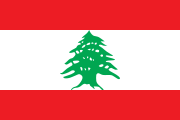 Lebanon: 27 February 1945
Lebanon: 27 February 1945 Syria: 27 February 1945
Syria: 27 February 1945.svg.png) Saudi Arabia: 1 March 1945
Saudi Arabia: 1 March 1945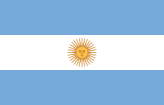 Argentina: 27 March 1945
Argentina: 27 March 1945 Chile: 11 April 1945
Chile: 11 April 1945
See also
- Free World (World War II)
- Participants in World War II
Footnotes
- ↑ "The Allies". U. S. Army Center of Military History and World War II History. http://worldwar2history.info/war/Allies.html. Retrieved 17 September 2009.
- ↑ Davies 2006, pp 150–151.
- ↑ The Real History of World War II: A ... – Google Books. books.google.co.uk. http://books.google.co.uk/books?id=GqYWmUae5h8C&pg=PA297&dq=%22The+Big+Three%22+world+war+II&as_brr=3&client=firefox-a#v=onepage&q=%22The%20Big%20Three%22%20world%20war%20II&f=false. Retrieved 2009-09-02.
- ↑ 4.0 4.1 4.2 Encyclopædia Britannica (2009). "Allied Powers – International Alliance also called Allies". Encyclopædia Britannica Online. http://www.britannica.com/EBchecked/topic/16380/Allied-Powers#ref754272.
- ↑ Hakim, Joy (1995). A History of Us: War, Peace and all that Jazz. New York: Oxford University Press. ISBN 0-19-509514-6.
- ↑ 6.0 6.1 6.2 "DECLARATION BY UNITED NATIONS". Book Department, Army Information School, Carlisle Barrack nars, Pa., May 1946 and ibiblio. 1 January 1942. http://www.ibiblio.org/pha/policy/1942/420101a.html.
- ↑ Kwan Yuk Pan (2005). "Polish veterans to take pride of place in victory parade". Financial Times, UK. http://www.ft.com/cms/s/0/0d441dfa-ecf1-11d9-9d20-00000e2511c8.html.
- ↑ A Decade of American Foreign Policy 1941–1949
- ↑ Doenecke, Justus D.; Stoler, Mark A. (2005). Debating Franklin D. Roosevelt's foreign policies, 1933–1945. Rowman & Littlefield. ISBN 084769416X. http://books.google.com/books?id=xdMF9rX6mX8C&pg=PA62&lpg=PA62&dq=Roosevelt+%22Four+Policemen%22&source=bl&ots=NiXqyQlKi8&sig=9GBBBxt3RvdTH1znsKi4N49bn9g&hl=en&ei=J5CkSrHPLpCEtgf0lqXXDw&sa=X&oi=book_result&ct=result&resnum=3#v=onepage&q=Roosevelt%20%22Four%20Policemen%22&f=false. Retrieved 7 September 2009.
- ↑ Douglas Brinkley, FDR & the Making of the U.N.
- ↑ Churchill, Winston S. (1981) [1953]. The Second World War, Volume VI: Triumph and Tragedy. Houghton-Mifflin Company. p. 561.
- ↑ After the Statute of Westminster of 1931, Dominions were granted full independence in their foreign relationships. Only treaties signed by the United Kingdom before that year could link them.
- ↑ "Military contribution of Poland to World War II – Wojsko Polskie – Departament Wychowania i Promocji Obronności". Wojsko-polskie.pl. http://www.wojsko-polskie.pl/articles/view/2339. Retrieved 2010-05-15.
- ↑ Molotov declaration of 17 September 1939
- ↑ Gordon, Leonard A., Review of Prosperity and Misery in Modern Bengal: The Famine of 1943–1944 by Greenough, Paul R., The American Historical Review, Vol. 88, No. 4 (Oct., 1983), p. 1051 <http://www.jstor.org/stable/1874145>
- ↑ LEAGUE OF NATIONS' EXPULSION OF THE U.S.S.R., DECEMBER 14, 1939
- ↑ Kenneth G. Weiss, The Azores in Diplomacy and Strategy, 1940–1945, Center for Naval Analyses, 1980, Alexandria, VA
- ↑ Overy 1997, pp 41, 43–7.
- ↑ Davies 2006, pp 148–51.
- ↑ Davies 2006, pp 16, 154.
- ↑ Toomas Alatalu. Tuva. A State Reawakens. Soviet Studies, Vol. 44, No. 5 (1992), pp. 881–895
- ↑ "Saga of the Aztec Eagles". Los Angeles Times Magazine. July 25, 2004. http://www.stelzriede.com/ms/html/mshwma39.htm. Retrieved July 11, 2010.
- ↑ http://www.yale.edu/lawweb/avalon/decade/decad058.htm
- ↑ Motter, T.H. Vail (2000). "The Persion Corridor and Aid to Russia". United States Army Center of Military History. http://www.history.army.mil/books/wwii/persian/index.htm#contents. Retrieved 2010-05-15.
- ↑ United Nations Security Council: Official Records: First Year, First Series, First Meeting
- ↑ Government-in-exile of Free France continued fighting with Britain from 18 June 1940 to 19 August 1944. Philippe Pétain's government formally capitulated on 22 June 1940 and the Vichy regime was later an Axis supporter. Free France contributed to Allied war effort; the Provisional Government of the French Republic was officially recognized by the Allies as the legitimate government of France, on 23 October 1944 (Ordre de la Libération). Pétain's demand of surrender in 1940 was also legally nullified, as was the Vichy regime as a whole (ref)
- ↑ While its foreign and military affairs were controlled by the UK, the British government gave its administrators in India the ability to act in certain matters and India was a member of the League of Nations.
- ↑ 28.0 28.1 "United Nations member States – Growth in United Nations membership, 1945–present". Un.org. http://www.un.org/en/members/growth.shtml. Retrieved 2010-05-15.
- ↑ Germany occupied Denmark in 1940 and the Danish government surrendered. The government disbanded in 1942 and Denmark was subject to direct rule by Nazi Germany. Denmark was accepted as a founding member of the UN in 1945.
- ↑ Formally member of Axis from 25 March to 6 April 1941, Yugoslavia was initially represented as an Ally by the government-in-exile of the Kingdom of Yugoslavia, a signatory to the Declaration by the United Nations.
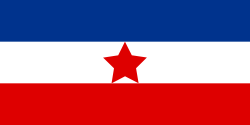 Democratic Federal Yugoslavia, which would succeed the kingdom, was founded on 29 November 1943 by the communist-led Yugoslav Partisans, who were recognised as the official Yugoslav armed resistance force two days later at the Tehran Conference.
Democratic Federal Yugoslavia, which would succeed the kingdom, was founded on 29 November 1943 by the communist-led Yugoslav Partisans, who were recognised as the official Yugoslav armed resistance force two days later at the Tehran Conference. - ↑ Despite members of USSR, Ukraine and Belarus were recognized as separate fighting States by UK and US at the end of the war, to reassure Stalin from a capitalistic dominance of the alliance.
- ↑ At war with the Empire of Japan since 1937.
- ↑ Philippine foreign and military affairs were limited and largely influenced by the United States. However, its government-in-exile signed the Declaration by United Nations on 10 June 1942.
- ↑ Government-in-exile, the state having been disbanded by Germany in March 1939. The exiled Czechs fought alongside the Allies since the very beginning of the war.
- ↑ Formerly annexed by Italy through the Abyssinia Crisis.
- ↑ 36.0 36.1 Occupied by Allies in 1941.
Bibliography
- Davies, Norman (2006), Europe at War 1939–1945: No Simple Victory. London: Macmillan. ISBN 0-333-69285-3
- Overy, Richard (1997), Russia's War: A History of the Soviet Effort: 1941–1945. New York: Penguin. ISBN 0-14-027169-4.
External links
- Changing Alliances In the International Arena
- The Atlantic Conference: Resolution of 24 September 1941
- WWII: Key Allied Figures – slideshow by Life magazine
|
||||||||||||||||||||||||||||||||||||||||||||||||||||||||||||||||||||||||